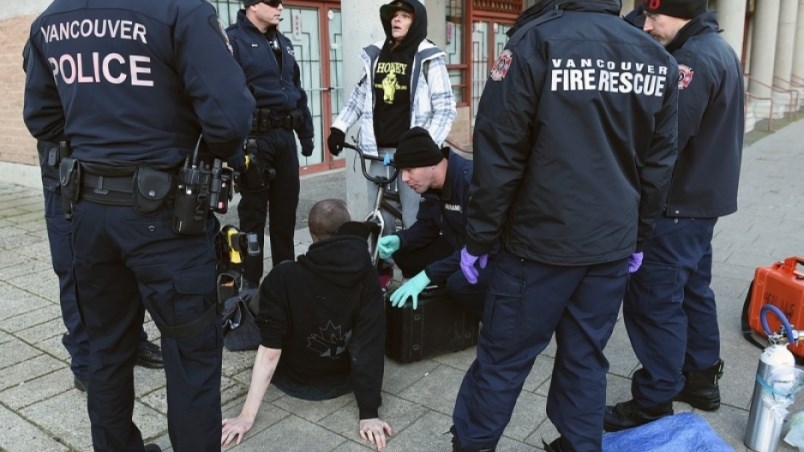B.C.’s illicit drug overdose death rate hit a monthly record high in October, putting the province on track for its most fatal year yet.
The province recorded 201 deaths, the highest-yet monthly death rate, according to the BC Coroners Service.
That brings the death rate for 2021 to 1,782 — or 6.5 deaths per day — the highest annual number so far with figures for November and December still to come.
"Today is a heart-rending milestone for our province," B.C.'s chief coroner Lisa Lapointe said. "In the sixth year of this public health emergency, we are experiencing a record loss of life and I know this news will resonate with tremendous sadness amongst the thousands of families who have lost a loved one to this crisis."
More than 8,300 people have died as a result of a toxic drug supply since the public health emergency was declared in April 2016.
"I feel British Columbians' grief and frustration," Minister of Mental Health and Addictions Sheila Malcolmson said during a news conference from Victoria. "We are doing everything we can to turn this drug crisis around."
"We are swimming against a rising tide of need," she said.
Malcolmson said the province is adding treatment beds, safe injection and inhalation sites and looking for gaps in the continuum of care — including the timing of people leaving detox facilities and getting into treatment centres.
The minister noted the province continues to work with her federal counterpart to decriminalize drugs.
"People who use drugs belong in the mental health system, not the criminal drug system," Malcolmson said.
The B.C. government is also continuing work on safe supply, moving to get more health-care professionals involved. That includes working with the various health-care professional colleges to get members on board.
"We are not doing nothing," Malcolmson said. "We are going as fast as we can. We all feel the urgency of this crisis."
Lapointe, meanwhile, couldn't stress enough how urgent the emergency has become.
"A comprehensive plan to ensure access to safe supply for the thousands of B.C. residents dependent on these substances is essential. Shifting from a punishment and stigmatizing regime to a decriminalized, health-focused model is also a critical step to reduce suffering and save lives," she said.
In 2021, 71% of those dying were aged 30 to 59, and 79% were male. The townships experiencing the highest number of deaths for the year are Vancouver, Surrey and Victoria.
The Fraser and Vancouver Coastal Health authorities, with 602 and 494 deaths, respectively, make up 62% of all such deaths for 2021.
By health authority this year, the highest rates were in Vancouver Coastal Health (48 deaths per 100,000 people) and Interior Health (45 per 100,000 people). Overall, B.C.’s rate is 41 deaths per 100,000.
The death rate began to soar in 2016 with 993 deaths, climbing to 1,493 and 1,558 in 2017 and 2018, respectively.
It dropped to 983 in 2019 before doubling to 1,7651 in 2020, a figure already eclipsed in 2021.
In 2021, 83% of deaths occurred inside (55% in private residences and 28% in other residences, including social and supportive housing, single-resident occupancy rooms, shelters, hotels and other indoor locations) and 15% occurred outside in vehicles, sidewalks, streets and parks, among other areas.
In Vancouver Coastal, other residences (47%) were the most common place of deaths followed by private residences (35%) between 2018 and 2021.
No deaths have been reported at supervised consumption or drug overdose prevention sites. The BC Coroners Service says there’s no indication that prescribed safe supply is contributing to illicit drug deaths.
Illicit drug toxicity death rates among people 19 years and older have remained high, while rates among those under 18 remain stable.
The proportion of deaths among those 50 years of age and older has steadily increased year after year for the past six years. In 2021, 39% of deaths were in that age bracket.
B.C. Green Party Leader Sonia Furstenau was critical of the NDP government's response. She called on all parties in the legislature to come together on the issue.
She said the issue requires an immediate expansion of regulated safe supply of drugs, harm reduction and access to a wide spectrum of treatment options, particularly Indigenous-run programs, and increased accessible mental health care.
“This is a public health emergency. Like we did under the minority government when COVID-19 first emerged, this toxic drug crisis demands an all-party approach instead of closed doors and slow actions," Furstenau said. "It is disappointing that this government would not choose to work with other parties. Together, we could share the burden of this responsibility, collaborate on solutions, and take urgent collective action.”
The latest BC Coroners Service report can be read online.



